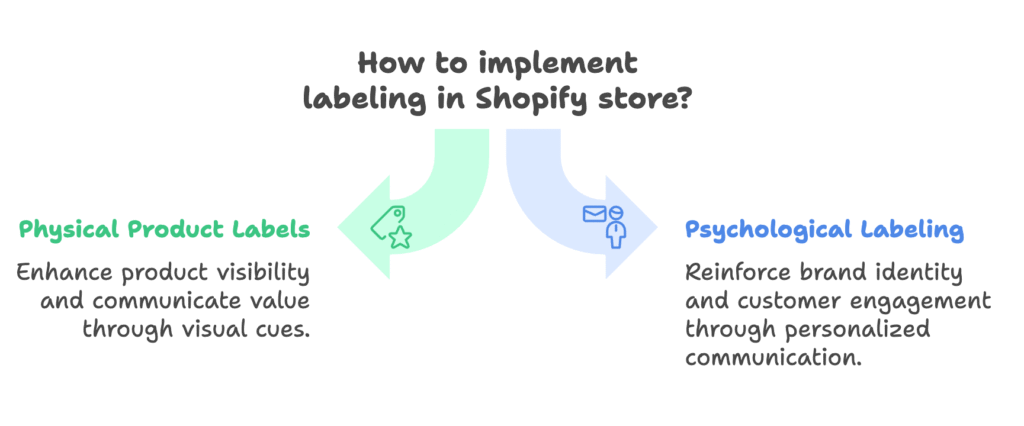Have you ever noticed how a simple label can completely change how you view yourself and the products you buy? Think about it: when a coffee shop loyalty card calls you a “Coffee Connoisseur,” you suddenly feel like an expert with refined taste. Or when you’re labeled an “Early Adopter” for buying a new gadget, you feel tech-savvy and ahead of the curve. This isn’t just clever marketing—it’s a powerful psychological technique that can transform casual browsers into loyal customers.
In this article, you’ll discover how the strategic use of labeling can dramatically boost your Shopify store’s conversion rates and customer loyalty. You’ll learn the science behind why labels work, practical ways to implement them, real-world success stories, and ethical guidelines to ensure you’re using this technique responsibly. Ready to harness the power of positive identity reinforcement? Let’s dive in!
Theoretical Foundations of Labeling
Before we start applying labels to everything in your store, let’s understand why they work so well. There’s fascinating science behind why humans respond so positively to being labeled—and it goes much deeper than just feeling good about a compliment.

Cognitive Psychology Principles
Three major psychological principles explain why labeling is so effective:
- Self-Perception Theory: When customers are labeled as “Eco-Conscious Shoppers” or “Style Innovators,” they’re more likely to adopt behaviors that match these labels. People naturally align their actions with how they’re identified or how they identify themselves.
- Social Identity Theory: Humans crave belonging to groups. When you label a customer as part of a desirable group (like “Smart Tech Early Adopters”), they feel a connection to others with that label and are motivated to maintain their membership through continued purchases.
- Halo Effect: A positive label doesn’t just affect how customers see themselves—it influences how they perceive your entire brand. When you recognize a customer as a “Sustainability Champion,” that positive feeling extends to everything associated with your store.
Neurological Impact
Labels don’t just influence our thoughts—they actually affect our brain chemistry:
- Dopamine Release: When a label validates our self-image, our brains release dopamine—the same “feel-good” chemical triggered by rewards. This creates a positive association with your brand.
- Anterior Cingulate Cortex Engagement: This brain region helps resolve conflicts. When labels align with how customers want to see themselves, decision-making becomes easier, reducing purchase hesitation.
- Mirror Neuron Activation: Our brains contain neurons that activate both when we perform an action and when we see others perform it. Labels that associate customers with aspirational groups tap into this mirroring system, encouraging behavior adoption.
Understanding these foundations isn’t just academic—it’s essential for effective implementation. When you know why labels work, you can create ones that resonate most deeply with your customers. Now that we have the science down, let’s explore how to put labels to work in your Shopify store!
Dual Applications of Labeling in Shopify Contexts
Labeling in e-commerce isn’t a one-size-fits-all approach. There are two distinct ways to implement this technique in your Shopify store, each with unique benefits and applications. Let’s explore both paths to find what works best for your business.

Physical Product Labels
The most visible form of labeling happens directly on your product listings. These visual cues instantly communicate value and trigger positive associations:
- Types of Effective Labels:
- Social Proof Labels: “Bestseller,” “Customer Favorite,” or “Top Rated” tags signal that a product is trusted and approved by others.
- Ethical Labels: “Carbon Neutral,” “Vegan Certified,” or “Fair Trade” badges appeal to customers’ desire to make responsible choices.
- Exclusivity Labels: “Limited Edition,” “Early Access,” or “Members Only” markers create a sense of privilege and uniqueness.
- Design Principles:
- Use color psychology to enhance your message—green for eco-friendly products, gold for premium items, red for urgency.
- Ensure mobile optimization with labels at least 24px in height for visibility on smaller screens.
- Position labels in high-attention areas like the top-left corner of product images or near the price.
Psychological Labeling in Customer Interactions
Beyond visual product tags, labeling works powerfully in your written communications with customers:
- Support Interaction Examples:
- “You’re clearly someone who values quality craftsmanship” (when a customer inquires about product details)
- “As a savvy shopper, you’ll appreciate this exclusive deal” (in response to price questions)
- “Your attention to detail shows you’re a true connoisseur” (when addressing specific product features)
- UX Copywriting Opportunities:
- Post-purchase emails: “Thank you, Sustainability Champion” or “Your Excellent Taste Has Been Confirmed”
- Cart abandonment messages: “Your Curated Collection Awaits, Style Expert” or “A Fashion Forward Decision Is Pending”
- Account creation confirmations: “Welcome to the Innovation Community” or “Your Journey as a Wellness Pioneer Begins”
The beauty of this dual approach is that you can reinforce the same identity across multiple touchpoints. A customer who sees a “Sustainable Choice” label on a product and is later addressed as an “Eco-Warrior” in an email experiences powerful identity reinforcement. Ready to create an organized system for implementing these labels across your store? Let’s build your labeling framework!
Implementation Framework
Having a systematic approach to labeling ensures consistency and effectiveness. In this section, we’ll create a practical framework that you can adapt to your specific Shopify store. Let’s turn theory into action with these two complementary systems.
Identity-Driven Product Labeling System
First, you’ll need to develop a coherent system for physical labels on your products:
- Customer Segmentation: Map your ideal customer archetypes to relevant labels and products:
Identity Archetype Label Examples Target Products Eco-Warrior “Plastic-Free Hero,” “Planet Protector” Reusable goods, sustainable products Tech Innovator “Early Adopter,” “Future-Ready” Gadgets, smart home products Luxury Connoisseur “VIP Exclusive,” “Curator’s Choice” High-end apparel, premium accessories - Placement Strategy:
- On mobile, place labels above the add-to-cart button where the F-pattern eye movement naturally focuses.
- For desktop, implement subtle animated hover effects (lasting about 0.8 seconds) to draw attention without being intrusive.
- Test different positions using heatmap tools to find the optimal placement for your specific store layout.
Conversational Labeling Protocol
Next, create a system for consistent identity reinforcement in your written communications:
- Chatbot Scripting:
- Program your chatbot to recognize browsing patterns and respond with identity-affirming language: “I see you’re building a minimalist wardrobe—this capsule collection fits your vision perfectly.”
- Create response templates for common questions that incorporate positive identity labels: “As someone with refined taste, you’ve made an excellent choice. This product’s craftsmanship includes…”
- Post-Purchase Reinforcement:
- Design order confirmation templates that reinforce the customer’s positive identity: “Your Ethical Starter Kit ships tomorrow, Earth Advocate.”
- Implement loyalty tiers with identity-based names rather than generic levels (e.g., “Wellness Guru” instead of just “Gold Level”).
- Schedule follow-up emails that continue to reinforce the customer’s identity: “How is your Minimalist Collection working for you, Simplicity Expert?”
Implementation doesn’t have to be complicated. Start small by adding labels to your best-selling products and most common customer communications. Then, track performance and expand your system based on what works. But does all this effort actually pay off? Let’s look at some real-world results that prove the power of effective labeling!
Measurable Outcomes & Case Studies
Talking about theory is one thing, but seeing real results is what really matters, right? These case studies demonstrate the concrete business impact of strategic labeling. Take notes on which approaches might work best for your specific Shopify niche.
Fashion Brand: 41% Repeat Purchase Increase
A mid-sized fashion retailer implemented a comprehensive labeling strategy with impressive results:
- Their Approach: They added “Trendsetter” labels to their newest collections and followed up with post-purchase emails addressing customers as “Style Icons.”
- The Results: Not only did they see a 41% increase in repeat purchases within 30 days, but an astounding 63% of customers who received these labels joined their premium loyalty program.
- Why It Worked: The labels tapped into their customers’ desire for fashion-forward identity, creating a sense of being “in the know” that customers wanted to maintain through continued engagement.
Eco-Store: 29% Higher Average Order Value
An eco-friendly product store used labeling to boost not just conversions but average order value:
- Their Strategy: They implemented “Zero-Waste Hero” badges at checkout and added carbon offset labels to premium products.
- The Impact: Average order value increased by 29%, and neurometric testing showed a 22% increase in ventral striatum activation (the brain’s reward center) during purchases.
- Why It Worked: The labels gave customers a way to see themselves as making a positive impact, turning their purchase from a simple transaction into an identity-affirming action worth spending more on.
Tech Retailer: 37% Lower Return Rate
A consumer electronics Shopify store found that the right labels could significantly reduce costly returns:
- Their Approach: They created “Tech Guru Exclusive” product tags and provided special “expert-tier” support for customers who purchased these items.
- The Outcome: Returns dropped by 37%, and 81% of labeled customers purchased extended warranties—a traditionally difficult upsell.
- Why It Worked: By labeling customers as tech experts, the store increased commitment to purchase decisions and created a sense of expertise that made customers more confident in their choices.
These examples show that labeling isn’t just theoretical—it delivers measurable results across different industries and metrics. However, with great power comes great responsibility. How do we ensure we’re using labeling techniques ethically and effectively? Let’s explore the guidelines that keep your labeling strategy on the right track.
Ethical Implementation Guidelines
Using labeling techniques effectively means doing so responsibly. Ethical implementation not only protects your customers but also builds sustainable trust in your brand. Let’s look at how to ensure your labeling strategy remains both powerful and principled.
Authenticity Requirements
The foundation of ethical labeling is truth—labels must reflect reality:
- Label Accuracy: Only use verified claims that you can substantiate. If you label a product as “Vegan,” ensure it has proper certification. If you call a customer a “VIP,” make sure they’re actually receiving preferential treatment.
- Avoid Cognitive Distortions: Don’t use labels that promote overgeneralization or all-or-nothing thinking. Labels should empower, not create unrealistic expectations or dependencies.
- Transparency: Be clear about what your labels mean. If “Bestseller” means “Top 10% of products in this category,” communicate that somewhere accessible to customers.
Inclusivity Standards
Effective labeling respects the diversity of your customer base:
- Multi-Identity Support: Allow customers to opt into labels rather than forcing identities upon them. Provide options that reflect different values and preferences.
- Cultural Sensitivity: Adapt your labeling approach for different markets and cultures. What works in one region might be ineffective or even offensive in another. For example, use “Sustainability Leader” in markets where “Eco-Warrior” might have political connotations.
- Accessible Language: Ensure your labels are clear and understandable to all customers, avoiding unnecessarily complex terminology or insider jargon.
Dark Pattern Prevention
Ethical labeling should never manipulate or deceive:
- No Forced Identity Adoption: Never use labels to pressure customers into actions they weren’t already considering (“Only bad parents wouldn’t buy this safety feature”).
- Transparent Label Removal: Make it easy for customers to reject or change labels that don’t resonate with them. Allow them to update preferences or opt out of certain messaging.
- Avoid Fear-Based Labeling: Don’t use negative labels or exclusionary language to drive purchases. Focus on positive identity reinforcement rather than fear of missing out.
Implementing these ethical guidelines doesn’t diminish the effectiveness of your labeling strategy—it enhances it by building genuine trust. As technology evolves, so too will the opportunities for innovative labeling. What might the future hold for this powerful technique? Let’s gaze into the crystal ball.
Future of Identity-Based Labeling
The labeling techniques we’ve explored are just the beginning. As technology advances and consumer behavior evolves, exciting new possibilities are emerging. Staying ahead of these trends can give your Shopify store a competitive edge for years to come.
Emerging Technologies
New technologies are revolutionizing how labels can be created and presented:
- AI-Powered Dynamic Labels: Imagine labels that adjust in real-time based on browsing behavior. A customer who spends time comparing fabric details might see a “Textile Connoisseur” label, while someone focusing on sustainability information would receive an “Eco-Conscious Shopper” identity—all personalized automatically.
- AR Identity Mirrors: Augmented reality is opening new frontiers for identity reinforcement. Soon, customers could use AR to try on products virtually while seeing identity-affirming overlays: “This look perfectly expresses your Modern Minimalist style” or “Your Vintage Enthusiast collection is coming together beautifully.”
- Voice-Activated Labeling: As voice shopping grows, verbal identity reinforcement will become increasingly important. Voice assistants could recognize returning customers and greet them with identity-affirming language: “Welcome back, Fitness Devotee. Would you like to see our newest high-performance gear?”
Predictive Personalization
The future of labeling goes beyond reacting to current behavior to anticipating future identities:
- Lifetime Identity Mapping: Advanced analytics will allow stores to track how customer identities evolve over time and predict future transitions. A customer currently identified as a “Minimalist Fashion Enthusiast” might be predicted to evolve toward “Sustainable Luxury Advocate”—allowing you to ease this transition with appropriately timed labels and recommendations.
- Neuro-Labeling: As consumer neurotechnology becomes more accessible, some premium brands might optimize their labeling through direct neurological feedback. EEG measurements could reveal which identity labels trigger the strongest positive brain responses for different customer segments, allowing for unprecedented personalization.
- Cross-Channel Identity Consistency: Future systems will ensure that a customer’s identity is consistently reinforced across all touchpoints—from social media ads to in-store experiences—creating a seamless identity narrative that strengthens brand connection.
While some of these technologies might seem futuristic, many are already in development or early implementation. The most forward-thinking Shopify stores are beginning to experiment now, positioning themselves at the forefront of this evolution in customer experience.
Conclusion
We’ve journeyed through the fascinating world of the labeling technique—from its psychological foundations to practical implementation strategies, real-world success stories, ethical considerations, and future possibilities. The power of positive identity reinforcement is clear: when you help customers see themselves in a positive light, they’re more likely to engage with your brand, make purchases that align with that identity, and develop lasting loyalty.
Remember, effective labeling isn’t about manipulation—it’s about recognition. It’s about seeing your customers for who they are (or aspire to be) and reflecting that understanding back to them. When done authentically, labeling creates a win-win situation where customers feel understood and valued while your business grows through deeper connections and increased conversions.
Start small by implementing a few strategic labels in your Shopify store. Watch how your customers respond, adjust your approach based on results, and gradually build a comprehensive labeling system that reinforces positive customer identities at every touchpoint.
Did you know? If you’re looking to take your Shopify store’s conversion optimization to the next level, Growth Suite offers a powerful way to complement your labeling strategy. With its intelligent visitor behavior tracking and personalized, time-limited offers, Growth Suite can help turn browsers into buyers while maintaining your brand’s premium image. The app integrates seamlessly with Shopify and can be set up in under 60 seconds—giving you more time to focus on crafting those perfect identity-affirming labels!




